SITE RESPONSE ANALYSIS USING MICROTREMORS - PowerPoint PPT Presentation
Title:
SITE RESPONSE ANALYSIS USING MICROTREMORS
Description:
SITE RESPONSE ANALYSIS USING MICROTREMORS Bo azi i University Kandilli observatory and Earthquake Research Institute Department of Geophysics Korhan Umut emin – PowerPoint PPT presentation
Number of Views:75
Avg rating:3.0/5.0
Title: SITE RESPONSE ANALYSIS USING MICROTREMORS
1
SITE RESPONSE ANALYSISUSING MICROTREMORS
- Bogaziçi University Kandilli observatory and
- Earthquake Research Institute
- Department of Geophysics
Korhan Umut Semin
2
OUTLINE
- Purpose of The Study
- What is Microtremor?
- Site response Analysis Techniques
- Reference site Dependent Techniques
- Non Reference site Dependent Techniques
- Examples
- Results
3
PURPOSE
- The applicability of microtremor measurements to
evaluation of site response. - Comparison with other site response estimation
methods.
4
What is Microtremor?
- Ambient seismic noises with very low amplitudes.
- Amplitude values change between 0.1-1 micron.
- Periods of microtremors change between 0.05-2 s.
- Short period microtremors consist of Rayleigh
waves excited locally from traffic disturbances
near the recording instruments. - Long period microtremors caused by atmospheric
perturbations over the oceans, and they propagate
as Rg and Lg phases over continental paths.
5
Site Response Analysis Techniques
- Reference site Dependent Techniques
- Spectral Ratio of s-waves
- Spectral Ratio of Coda-waves
- Non Reference site Dependent Techniques
- Receiver Function Method (H/V)
- Nakamuras Technique
6
Reference Site Dependent Techniques
- These methods consider the ratio between the
spectrum at a site of interest and the spectrum
at a reference site. - Reference site is usually a nearby rock site.
- Earthquake aftershock data are used.
- These methods depend on the availability of
reference site. - The coda wave method is popular due to the
abundance of data provided by microearthquake
observation networks.
7
Non Reference Site Dependent Techniques
- Receiver function technique assumes that the
local site conditions are relatively transparent
to the vertical motion. - This method uses the spectral ratio between the
horizontal and vertical components of motion.
8
Nakamuras Technique
- This technique relies on the interpretation of
microtremors as Rayleigh waves propagating in a
single layer over a half space. - Neglects any contribution from deep sources.
- Assuming very local sources, will not affect
microtremor motion at the base of the soft soil
layer. - For all frequencies of interest, HB(w)/vb(w)1
- Site effect HS(W)/VS(W)
9
EXAMPLES
10
(No Transcript)
11
(No Transcript)
12
(No Transcript)
13
(No Transcript)
14
(No Transcript)
15
RESULTS
- Receiver function type estimates are successful
in identifying the frequency dependence of site
response. - Nakamuras technique isolates the source (and
possibly path) effects from the site effects. - It is possible to estimate dominant period and
rough amplification level of soft sediments by
measuring directly the dominant period of
microtremors and its maximum amplitude.































